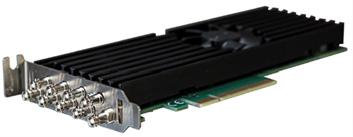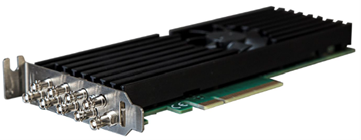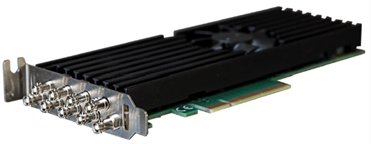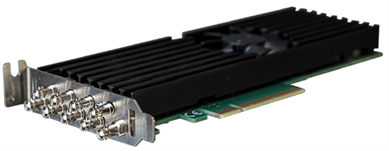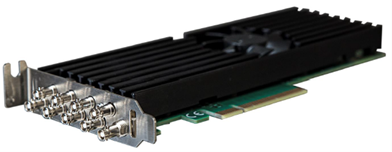Thursday, November 28, 2019 - 12G-SDI information and products tour by DELTACAST
What is 12G-SDI?
To make a long story short, a 12G signal is a single-wire multiplex of eight 148.5 MHz sources, meaning 8x HD-SDI, or 4x 3G-SDI.
SMPTE ST2082-1 defines the 12G-SDI signals electrical and physical characteristics for the transport of video content over coaxial cable interface.
The primary purpose of 12G-SDI is to convey 2160-line pictures – aka 4K or UHD – on a single wire. This usage of 12G interfaces is standardized as SMPTE ST2082-10 Mode 1.
There also exists a Mode 2 dedicated to the transport of HFR (High Frame Rate) HD video, now the focus and market interest are currently more on UHD than on HFR. Let us know if you have a different mind!
2160p transport over 12G-SDI is based on the 2 sample interleave sub-division defined in ST425-5, where the 8 data streams are then multiplexed on the 12G interface :

From the application perspective, quad-link transport using ST425-5 and single-link transport using ST2082-10 are very similar.
How does DELTACAST address 12G-SDI?
Since ever, an important point of the DELTACAST strategy is to follow the evolution of broadcast standards closely and to provide products dealing with latest norms, to ease market adoption and technological transitions of our customers.
12G-SDI makes fully part of this strategy, as DELTACAST is active on the 12G road since years with some early adopters. Then, feeling an appropriate answer from the market, DELTACAST officially added the first 12G-SDI products to its portfolio in 2018.
DELTACAST clearly associates 12G interface to 4K formats, and multi-link 12G to 8K transport, but that does not make it all, like you will read below.
Today, the DELTACAST products offer includes 6 cards and 2 FLEX modules with 12G-SDI capabilities, and at least 3 additional products are currently in design stage and will progressively expand the portfolio in 2020.
All these products comply with the latest revision of the SMPTE ST2081 (6G-SDI) and ST2082 (12G-SDI) families of standards. They support all the most popular UHD and 4K transport formats currently used in the industry : quadrants and 2SI, and over quad-link HD-SDI, quad-link 3G-SDI, single-link 6G-SDI and single-link 12G-SDI.
Let’s review them :
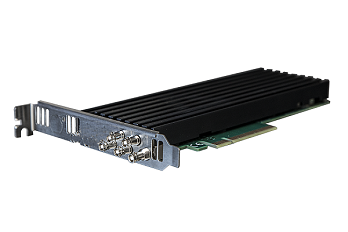 |
DELTA-12G-elp-h 1c This low-density card is the evolution of the very popular DELTA-3G-elp-d 4c, with one of the channels being boosted to support 6G and 12G-SDI. The DELTA-12G-elp-h 1c is also a high performing quad-channel 1080p card! |
|
|
DELTA-12G-elp-h 2c This high-density card supports 2 simultaneous UHD/4K streams, or up to 8 simultaneous HD channels. It is an excellent evolution path from the DELTA-3G-elp-d 8C, with 2 of the 8 channels being 6G and 12G-SDI capable. |
|
|
DELTA-12G-elp-h 20 The DELTA-12G-elp-h 20 is a specific version of the DELTA-12G-elp-h 2c, optimized for input-only use cases and packed with an additional feature set dedicated to input signal processing, and analysis. |
|
Note that you can freely and easily switch firmware configurations between DELTA-12G-elp-h 20 and DELTA-12G-elp-h 2c. |
|
|
|
DELTA-12G-elp-h 40 The DELTA-12G-elp-h 40 is an 8-input capture card with 4 of its connectors supporting up to 12G-SDI, and the 4 other ones supporting up to 3G-SDI. This supercharged card can handle four simultaneous 4K or UHD feeds. Additionally, it can combine these four 4K quadrants into a single 8K framebuffer, at up to 60 fps! The DELTA-12G-elp-h 40 also implements input signal analysis and processing features. |
|
|
DELTA-12G-elp-h 04 The DELTA-12G-elp-h 04 is an 8-output playout card with 4 of its connectors supporting up to 12G-SDI, and the 4 other ones supporting up to 3G-SDI. The card can hence emit up to eight 1080p streams, or four 4K ones, or one 8K60. In this last case the application deals with a single 8K framebuffer and the card takes in charge the split into four synchronized 4K quadrants, each one being emitted on a 12G-SDI output. |
|
|
DELTA-12G-elp-h 22 The DELTA-12G-elp-h 22 is the most versatile card of the DELTACAST 12G-SDI portfolio. It hosts eight bidirectional 3G-SDI channels, making it suitable for any use case requiring a combination of up to eight 1080p inputs and outputs. Moreover, two of the eight connectors can be used as 6G-SDI or 12G-SDI inputs, and two other connectors can be used as 6G-SDI or 12G-SDI outputs. This card can hence handle two complete UHD input-output pipelines. |
|
Note that you can freely and easily switch firmware configurations between DELTA-12G-elp-h 40, DELTA-12G-elp-h 04 and DELTA-12G-elp-h 22. |
|
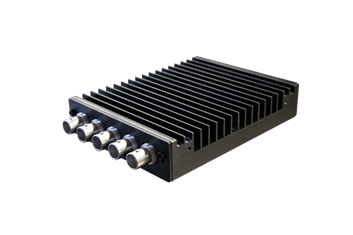 |
FLEX-12G 10 The FLEX-12G 10 module is a new option in the DELTACAST FLEX portfolio. This capture module hosts four 3G-SDI inputs, with one of them supporting 6G-SDI and 12G-SDI. The module is tailored for the capture of one 4K60 10-bit feed, and it also supports the concurrent capture of up to four 1080p signals. |
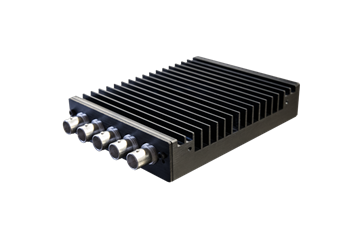 |
FLEX-12G 01 FLEX-12G 01 is a playout module hosting four 3G-SDI outputs, with one of them supporting 6G-SDI and 12G-SDI. The module can handle one 4K60 10-bit stream, or the concurrent transmission of up to four 1080p signals. |
Is that all?
Besides dealing with 12G signals, these cards and FLEX modules are also the highest-performing devices for 3G-SDI interfacing, and still support 1.5Gbps HD and even standard definition resolutions.
Particularly, the DELTA-12G-elp-h cards are PCIe Gen3 x8 devices, meaning that they offer superior DMA transfer performances compared to previous generation cards. Concretely, a 1080p frame DMA latency is divided by two compared to a PCIe Gen2 x8 card like the DELTA-3G-elp-d 4c, and by four compared to a PCIe Gen2 x4 board like the DELTA-3G-elp-d 40.
Embracing that new-generation platform, your design is future-proof and ready for forthcoming evolutions. Expect to welcome new DELTACAST products completing our 12G-SDI cards portfolio in the coming months, especially if you look in the direction of more versatility, higher density or mixed interfaces.
It is time for you to have a closer look at these new cards and FLEX modules!

